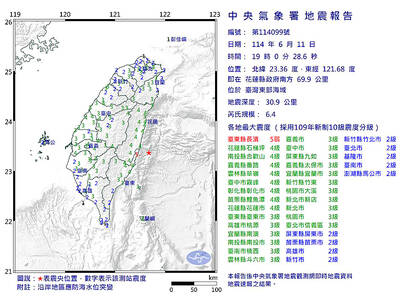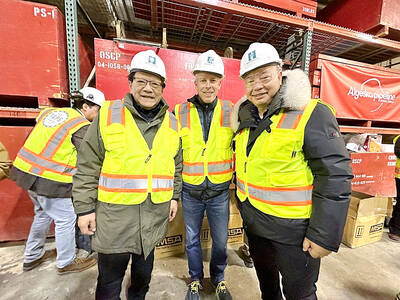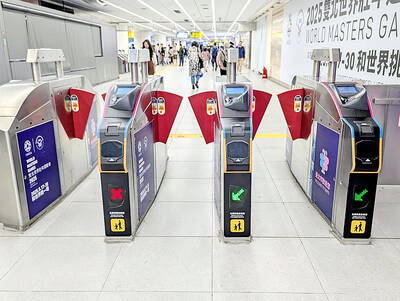About 200 Aborigines yesterday held a demonstration on Ketagalan Boulevard in Taipei to support three campaigners staging a sit-in protest against recently announced guidelines on the delineation of traditional Aboriginal territories.
The demonstrators from the Indigenous Youth Front performed traditional songs and danced for more than an hour before dispersing.
The Council of Indigenous Peoples announced the guidelines on Feb. 14, but they were opposed by Aboriginal rights groups and lawmakers, as they stipulate that private land would not be recognized as traditional Aboriginal territories.
Aboriginal folk singers and rights campaigners Nabu Husungan Istanda and Panai Kusui and documentary filmmaker Mayaw Biho started a sit-in protest in front of the Presidential Office Building on Ketagalan Boulevard on Feb. 23.
“The guidelines exclude private lands and will cause traditional territories to become fragmented,” the front said. “The council says that this is a step forward from zero to 800,000 hectares [of traditional Aboriginal territories], but we can foresee various land development cases in villages that no longer need to respect local tribes and unable to hear the land weeping.”
The front said the three campaigners have been staging a sit-in for more than 10 days, so it is time for them, mostly university students, to show their support and show the government that many young people are also concerned about the issue.
They said that the integrity of the traditional territories can help Aboriginal communities learn traditional ecological knowledge and allow them to develop the most suitable culture and lifestyles for living in the area.
A member of the front, Mo’o, who is an undergraduate student at National Taiwan University, said the exclusion of private lands will harm the integrity of traditional Aboriginal territories, and Aborigines will not have the right to express their opinions in land development cases.

A magnitude 6.4 earthquake struck off the coast of Hualien County in eastern Taiwan at 7pm yesterday, the Central Weather Administration (CWA) said. The epicenter of the temblor was at sea, about 69.9km south of Hualien County Hall, at a depth of 30.9km, it said. There were no immediate reports of damage resulting from the quake. The earthquake’s intensity, which gauges the actual effect of a temblor, was highest in Taitung County’s Changbin Township (長濱), where it measured 5 on Taiwan’s seven-tier intensity scale. The quake also measured an intensity of 4 in Hualien, Nantou, Chiayi, Yunlin, Changhua and Miaoli counties, as well as

Credit departments of farmers’ and fishers’ associations blocked a total of more than NT$180 million (US$6.01 million) from being lost to scams last year, National Police Agency (NPA) data showed. The Agricultural Finance Agency (AFA) said last week that staff of farmers’ and fishers’ associations’ credit departments are required to implement fraud prevention measures when they serve clients at the counter. They would ask clients about personal financial management activities whenever they suspect there might be a fraud situation, and would immediately report the incident to local authorities, which would send police officers to the site to help, it said. NPA data showed

ENERGY RESILIENCE: Although Alaska is open for investments, Taiwan is sourcing its gas from the Middle East, and the sea routes carry risks, Ho Cheng-hui said US government officials’ high-profile reception of a Taiwanese representative at the Alaska Sustainable Energy Conference indicated the emergence of an Indo-Pacific energy resilience alliance, an academic said. Presidential Office Secretary-General Pan Men-an (潘孟安) attended the conference in Alaska on Thursday last week at the invitation of the US government. Pan visited oil and gas facilities with senior US officials, including US Secretary of the Interior Doug Burgum, US Secretary of Energy Chris Wright, Alaska Governor Mike Dunleavy and US Senator Daniel Sullivan. Pan attending the conference on behalf of President William Lai (賴清德) shows a significant elevation in diplomatic representation,

The Taipei MRT is to begin accepting mobile payment services in the fall, Taipei Rapid Transit Corp said on Saturday. When the company finishes the installation of new payment units at ticketing gates in October, MRT passengers can use credit cards, Apple Pay, Google Pay and Samsung Pay, the operator said. In addition, the MRT would also provide QR payment codes — which would be compatible with Line Pay, Jkopay, iPass Money, PXPay Plus, EasyWallet, iCash Pay, Taiwan Pay and Taishin Pay — to access the railway system. Currently, passengers can access the Taipei MRT by buying a single-journey token or using EasyCard,